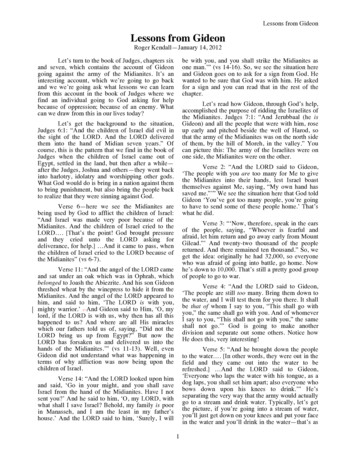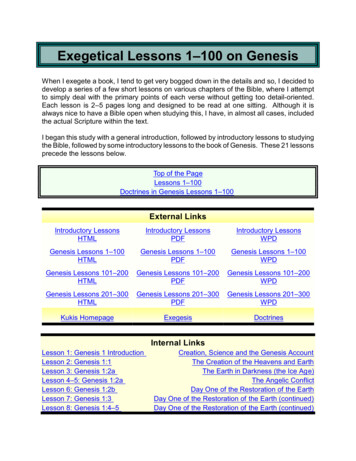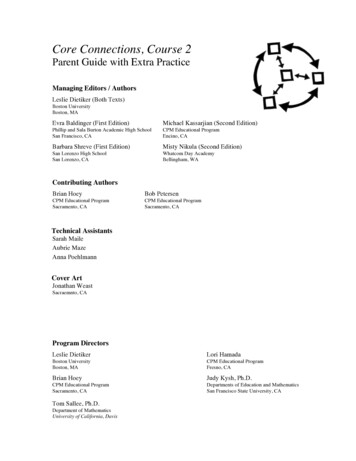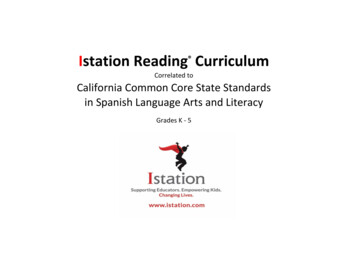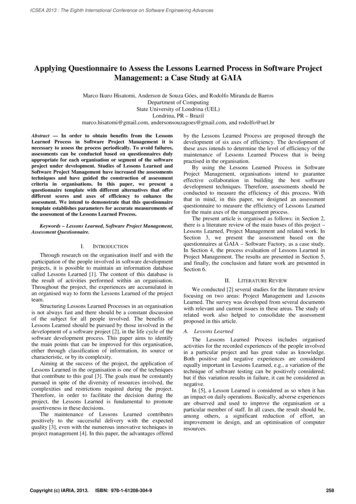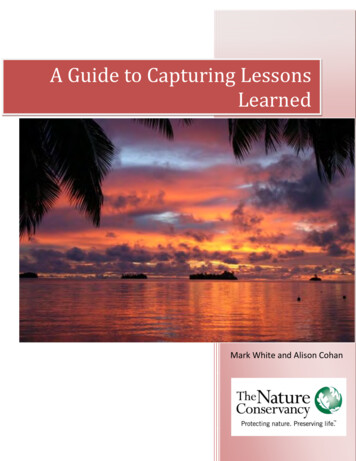
Transcription
A Guide to Capturing LessonsLearnedMark White and Alison Cohan
ContentsBasic Lessons Learned Process . 21.Define the Project . 22.Collect . 23.Verify and Synthesize . 24.Store . 25.Disseminate. 2Deciding on a process for collecting lessons learned . 2Approach 1. Integrated. 3Approach 2. Post-Facto . 3Approach 3. Combination . 5Process Details . 6Identifying the project team . 6Selecting the lesson learned writer/leader . 6Identifying Lessons Learned . 7Dissemination strategy . 8Suggested Lessons Learned Case Study Format . 9Appendices. 11List of Figures and TablesFigure 1. Basic lessons learned process . 1Table 1. Simplified, integrated process for capturing lessons learned from project onset . 3Table 2. Step-by-step detailed process for capturing lessons learned post-facto. . 4Table 3. Pros and cons of simple, integrated versus detailed, post facto methods of collectinglessons learned. . 5Table 4. Combined process for capturing lessons learned throughout project duration. . 5
A Guide for Capturing Lessons LearnedThroughout a project’s life cycle, we learn lessons and discover opportunities for improvement.As a key part of The Nature Conservancy’s Conservation by Design principles, documentinglessons learned helps a project team discover both strengths and weaknesses. It provides anopportunity for team members and/or partners to discuss successes during the project,unintended outcomes, and recommendations for others involved in similar future projects. Italso allows the team to discuss things that might have been done differently, the root causes ofproblems that occurred, and ways to avoid those problems in later project stages.Use of lessons learned is a principal component of an organizational culture committed tocontinuous improvement and adaptive management. Lessons learned mechanismscommunicate acquired knowledge more effectively and ensure that beneficial information isfactored into planning, work processes, and activities. The mechanisms or processes used tocollect, share, and disseminate lessons learned may vary, but in general such a process iscomprised of five main elements: defining the project, collecting information, verifyingapplicability, storage, and dissemination. Figure 1 is a generic representation of the lessonslearned process. Appendix 1 offers general guidelines for capturing lessons learned.Disseminatepast lessonsor bestpracticesLessonslearnedrepositoryReuseDefine thelessonslearnedprojectApplyingKnowledgeReview forapplicabilityCollection oflessons andpracticesFigure 1. Basic lessons learned processModified from Weber, R., Aha, D., and Becerra-Fernanadez, I. Categorizing Intelligent Lessons Learned Systems. Intelligent Lessons LearnedSystems: Papers from the AAAI Workshop (Technical Report AIC-00-005). Aha, D.W. and Weber, R. (Eds.) pp. 63-67. Washington, DC: NavalResearch Laboratory, Navy Center for Applied Research in Artificial Intelligence, 2000.A Guide to Capturing Lessons LearnedPage 1
Basic Lessons Learned Process1. Define the ProjectThis step is the initial step wherein the need for lessons learned is identified and the processand team through which the lessons will be collected is established. It is important to establishthe specific need and purpose for lessons, the audience for the product, and which individualsshould comprise the project team. Initial engagement from all key players should beestablished in advance of the project. Select staff with specific expertise or knowledge of theproject and other needed skills, such as communication and writing. The team should thenagree to a product format (length, style, and presentation), data collection and analysismethodologies (e.g., surveys, questionnaires, workshops) and process, dissemination strategy,and other activities that will be needed.2. CollectThe collection process involves the capture of information through structured and unstructuredprocesses such as project critiques, written forms, and meetings. The collection of lessons maycome from as many sources as an organization is willing to solicit. Lessons learned can be basedboth upon positive experiences that achieve organization goals, and on negative experiencesthat result in undesirable outcomes. For some projects, a collaborative lessons collectionprocess can be as or more important as documenting the lessons.3. Verify and SynthesizeThis process serves to verify the accuracy and applicability of lessons submitted. Domain orsubject matter experts may be involved in coordinating and conducting reviews to determinewhether or not a lesson is relevant across many other projects, is unique to a particulardepartment or project, or applies to the organization as a whole.4. StoreThe storage aspect of lessons learned usually involves incorporating lessons into an electronicdatabase for future sharing and dissemination. Information should be stored in a manner thatallows users to identify search lessons by keyword.5. DisseminateThe final element, and the most important, is the dissemination of lessons learned, sincelessons are of little benefit unless they are distributed and used by people who will benefit fromthem. Dissemination can include the revision of a work process, training, and routinedistribution via a variety of communication media. Lessons can be “pushed,” or automaticallydelivered to a user, or “pulled” in situations where a user must manually search for them.Deciding on a process for collecting lessons learnedThere are primarily two different approaches to capturing lessons learned, and each projectteam must decide which approach, or perhaps a combination of approaches, works best forA Guide to Capturing Lessons LearnedPage 2
their project. Both approaches are described below, and a third “combination” approach thatcombines Approaches 1 and 2 is offered as well.Approach 1. IntegratedThe simplest approach is to incorporate lessons learned early, regularly, and consistentlythrough regular project reporting, or within the context of the initial management plan.Capturing lessons learned would be part of the regular annual or semi-annual reporting cycleand may even be embedded in the initial project management plan. Table 1 outlines thisintegrated approach. One major advantage of this method is that there need not be a separateand often costly lessons learned project with an outside leader or team, but instead the processis embedded within the project plan, and is carried out by the project manager or internaldesignee. This approach is far less resource-intensive.Table 1. Simplified, integrated process for capturing lessons learned from project onsetStep 1Project manager meets with staff every 3-6 months to identify and discuss top keylessons. (The timing of this process can be tied with specific reportingrequirements or be done more or less frequently if desired.)Step 2Project manager or assignees synthesizes discussion and enters summary pointsinto the case study format (see below).Step 3Project manager or assignee submits/synthesizes lessons (in case study or otherformats) in semi-annual and annual progress reports.*Step 4Central lessons learned coordinator disseminates lessons, either through regularlyupdated website or internal newsletter, or holds annual workshop on top lessonslearned for sharing between projects. Coordinator might also identify similarprojects that can most benefit from specific lessons shared and facilitate shortworkshop.*More detail is provided on these steps below.Approach 2. Post-FactoThe more detailed, complex approach is one which requires a thorough examination of theproject post-facto. This is sometimes done in projects reactively or as an afterthought whenproject managers realize things could have been done differently. However, many organizationswho have invested heavily in a project over a long period of time, or who are interested inreplicating similar projects are willing to spend the time and money necessary to improvefuture efficiency. While more resource-intensive, this approach offers the benefit of bringingproject members and partners together for an extensive look into the operations, successes,and shortcomings of the project. Table 2 outlines a process for capturing lessons learned in athorough manner at the end of a project. The steps can be modified or rearranged to meet theproject’s needs; however it is good practice to follow a methodical approach. The next sectionprovides further detail on steps in this approach, such as identifying the project team, andchoosing a lessons learned writer/leader, data collection method, and dissemination strategy.Table 3 outlines the pros and cons of each method.A Guide to Capturing Lessons LearnedPage 3
Table 2. Step-by-step detailed process for capturing lessons learned post-facto.Define the ProjectStep 1Step 2Step 3Step 4*Step 5Step 6Step 7Step 8Step 9Step 10*Step 11Step 12Step 13Identify the need for lessons learned. Clarify the purpose and audience beforeproceeding.Identify any specific issue(s) that might provide an appropriate focus for the lessonslearned work.Define the lesson learned project – draft Terms of Reference (TOR), charter, and budget.Include objectives, timeline, audience, indicators of success, resources needed,dissemination strategy, and other core needs.Identify the project team. Build initial engagement from all key players who will beinvolved in advance of the project. Select staff with specific expertise or knowledge of theproject and other needed skills, such as communication and writing.Confirm budget, resources, and team availability.Identify the key characteristics, experience, and qualifications of the writer/leader.Select the lessons learned writer/leader.Have the writer sign an agreement and associated TOR, charter and budget to definescope of effort and commitment.Arrange for the lessons learned writer/leader and project team to meet and further refinethe charter and develop a specific schedule. Steps 10 through 13 below can best beaccomplished through a facilitated meeting with the project team.Have the team agree to a product format (length, style, and presentation), data collectionmethodologies (e.g., surveys, questionnaires, workshops) and process, disseminationstrategy, and other activities that will be needed.Determine if additional external reviewers are needed and who they are.Develop a questionnaire and interview methodology if data will be collected from others.Identify key factors, topic areas and issues that questions should address to meet theneeds of the project.Design, refine and agree to the data analysis process. Identify all of the documents andindividuals/groups that will provide the appropriate information.Data CollectionStep 14Collect the data from primary (e.g., interviews) and secondary sources (e.g., documents,meeting minutes). Review project material such as previously gathered lessons learnedmaterial and the reports to get a sense of project issues and successes.Verify and SynthesizeStep 15Summarize the data for the lessons learned in the agreed upon lessons learned formatand create a draft lessons learned document.Send draft lessons learned document to the peer review team.Revise the draft and get the final version approved by the project initiator(s).Step 16Step 17StoreStep 18*Store organized lessons learned in a database, website, or other lessons repository.DisseminateStep 19**Finalize and implement the lessons learned dissemination strategy.More detail is provided on these steps below.A Guide to Capturing Lessons LearnedPage 4
Table 3. Pros and cons of simple, integrated versus detailed, post facto methods of collectinglessons learned.Integrated methodProsConsLess costlyFocus within organization maynot allow broader perspectiveor include partners’ lessonsLess time-intensivePost-facto methodBrings multiple partnerstogether for extensiveanalysesProcess can be designed tobuild better collaboration andcommunication within apartnershipResource-intensive (time andmoney)Often requires specializedlessons learned leader orfacilitatorApproach 3. CombinationWhile it is preferred to begin with the integrated approach wherein lessons learned are part ofthe initial project plan and team members meet regularly to capture lessons learned, it is alsohelpful to bring together key partners and stakeholders with the project team and the end of orduring a project. This allows for a broader analysis and may help to build a sense ofcollaboration and communication within the partnership or group responsible for projectimplementation. Table 3 outlines how this combined approach may unfold.Table 4. Combined process for capturing lessons learned throughout project duration.Step 1Step 2Step 3Step 4Step 5Step 6*Project manager meets with staff every 3-6 months to identify and discuss top key lessons.(The timing of this process can be tied with specific reporting requirements or be done moreor less frequently if desired.)Project manager or assignees synthesizes discussion and enters summary points into the casestudy format (see below).Project manager or assignee submits/synthesizes lessons (in case study or other formats) insemi-annual and annual progress reports.An annual and/or end of project facilitated group discussion FGD involving key partners andstakeholders–possibly facilitated by TNC, partners, or by third party (depending on how theinstitutional arrangement of the project and the conditions of the relationships). A survey canbe added for partner participants attending the discussion to capture their views of thelessons learned.Key lessons are summarized and distributed to all who participate in the group.Central lessons learned coordinator disseminates lessons, either through regularly updatedwebsite or internal newsletter, or holds annual workshop on top lessons learned for sharingbetween projects. Coordinator might also identify similar projects that can most benefit fromspecific lessons shared and facilitate short workshop.A Guide to Capturing Lessons LearnedPage 5
Process DetailsIdentifying the project team (Approaches 2 and 3)In identifying the project team, it is important to build initial engagement from all key playerswho will be involved in advance of the project. Include the project manager, the project team,and the key stakeholders in the lessons learned exercise. Select staff with specific expertise orknowledge of the project and other needed skills, such as communication and writing.Selecting the lesson learned writer/leader (Approaches 2 and 3)There are a few different approaches in selecting a lessons learned leader. We suggest pickingsomeone with good or at least some familiarity with the larger organization’s goals and processbut not someone directly involved in the daily operations of the project. There is certainlysomething to be said for having an outsider that is an expert in capturing lessons learned leadthe process. The outsider obviously will have no knowledge of the project and thus no inherentbiases. However, the downsides to this approach are that there may be less buy-in from theproject team members, stakeholders or partners may be less willing to share information with astranger, and some insider information may be lost in the process. One alternative to thisapproach is to pair the expert with the project manager or another insider heavily involved inthe project. Then the two could work as a team to lead the process and hone the lessonslearned. Another alternative, as suggested above, is to have the project team itself identify anddevelop the lessons learned through an iterative, adaptive process throughout the life of theproject.Data collection methods and storage (Approaches 2 and 3)See Appendix 2 for a detailed analysis of the purpose, advantages, and disadvantages fordifferent data collection options (e.g., surveys, interviews, workshops, reviews).Multiple resources exist for creating questionnaires and surveys, and designing interviewquestions. One free, user-friendly survey website is SurveyMonkey.com(www.surveymonkey.com), which offers advice for question design and also offers basic dataanalysis and display options. This document provides excellent guidance on conducting a surveyand designing a questionnaire - r method you are using, concentrate on obtaining information in four general areas:1. What went well?2. What didn't go well or had unintended consequences?3. If you had it all to do over again, what would you do differently?4. What recommendations would you make to others doing similar projects?You can include other more detailed questions in your survey or interview, such as:A Guide to Capturing Lessons LearnedPage 6
Were the project goals attained? If not, what changes need to be made to meetgoals in the future?What surprises did the team have to deal with?What project circumstances were not anticipated?Did you develop any useful workarounds or solutions to problems that cropped upduring the project? Document the details in a way that will make sense later.For any problems that went unresolved what preventative measures can you inventnow that can help things go more smoothly next time?Are there any new “best practices” you can derive from this project? Note anythingthat went so well – and now seems to be so thoroughly “road tested” – that youwould want to repeat the positive experience next time.Can you create an easily accessible repository for lessons learned and best practicesyou have documented? This could be a database, website, or even a simpledocument.Identifying Lessons Learned (All approaches)The guidelines below are modified from the book "Learning to Fly - Practical knowledgemanagement from leading and learning organisations")1, and set out ten key steps tofacilitating a lessons learned review.1. Call the meeting. If conducting a post-facto process, hold a face-to-face meeting as soon asyou can after the project ends, within weeks rather than months.2. Invite the right people. The project leader needs to attend, as do key members of theproject team. If a similar project is already underway, then there is great value in the newproject team attending - a "customer" for the knowledge.3. Appoint a facilitator. Identify a facilitator who was not closely involved in the project. Thefacilitator should be someone who can ask questions from an independent, but nonthreatening standpoint. This isn't an audit, it's an investment!4. Revisit the objectives and deliverables of the project. Ask "what did we set out to do?" and"what did we achieve?"5. Go through the project step by step. Revisit the project plan and identify any deviation fromplan. Where were the delays, and what went ahead of schedule? What changed and why?6. Ask “what went well”? Ask "what were the successful steps towards achieving yourobjective?" and "what went really well in the project?"Ask a "why?" question several times. This is vital, and will get you to the root of the reason.Don't take the initial response at face value. Often people don't even realise what theunderlying reason behind a success or failure is.7. Find out why these aspects went well, and express the learning as advice or guidelines forthe future. This is a key point. Try to avoid expressing lessons learned in a passive, pasttense, such as: "Project Foxtrot completed ahead of schedule because the project teamremained in-tact throughout the design and execution stages".1By Chris Collison and Geoff Parcell, www.chriscollison.com/l2f/ year?A Guide to Capturing Lessons LearnedPage 7
The lesson will be far more accessible to others if it is expressed as:"On time-critical projects, ensure that the project team remains consistent throughout thedesign and execution stages of the project. This will eliminate any learning-curve issues dueto the take-on of new staff".As the facilitator, acknowledge feelings and press for the facts. Ask "what repeatable,successful processes did we use?” and ”how could we ensure future projects go just as well,or even better?”8. Ask "what could have gone better?" Ask "what were the aspects that stopped youdelivering even more?" Identify the stumbling blocks and pitfalls, so they can be avoided infuture by asking "what would your advice be to future project teams, based on yourexperiences here?"9. Ensure that participants leave with their feelings acknowledged. Ask for "Marks out of ten"and "What would make it a ten for you?" to access residual issues.10. Record the meeting. Use quotes to express the depth of feeling. Express therecommendations as clearly, measurably and unambiguously as possible, using theguideline format explained in point 7. Take a photograph of the project team, and ensurethat you record contact information (e-mail and telephone) to make follow-upconversations easy for anyone reading he lessons learned. Ensure that you circulate thewrite-up around the participants for comment, and permission to use specific quotes beforesharing more widely.Dissemination strategy (All approaches)Once you have captured lessons learned, make sure they are easily referenced by other projectteams. Keep them in a location where they can be easily found and searched – maybe a projectportal or intranet site. Start every project by accessing past project lessons learned. Trackimproved effectiveness and efficiencies on projects based on applying the lessons learned frompast projects. In this way, the lessons learned from past projects help to increase the success offuture projects. Make a component of every project a requirement to review the lessonslearned from past projects. Strive to create a set of enabling conditions that foster anorganizational culture of capturing and adapting behavior based on identified lessons learned.See Appendix 3 for options for disseminating lessons learned.A Guide to Capturing Lessons LearnedPage 8
Suggested Lessons Learned Case Study FormatTitle:Period covered:Date of the report:Case Overview (½ - ¾ page):BackgroundProject Objectives/GoalsConservation impact (1-2 paragraphs):Evaluative description of results/measures (include timeline)What worked well? (1-2 paragraphs):Could include quotes from partners/staff - reflective description on lessons learnedWhat didn’t work so well? (1-2 paragraphs):Could include quotes from partners/staff - reflective description on lessons learnedIf you had it all to do over again, what would you do differently? (1-2 paragraphs):What recommendations would you make to others doing similar projects? (1-2 paragraphs):Would the above two questions providing similar descriptions?Suggestions for others (1-2 paragraphs):Could include quotes from partners/staff – prescriptive adviceResources: Links to other relevant informationMetadata: -- would the information below appear at the bottom of the case study report?Author: Name/Job Title/OU/Region/emailLocation of Project: Region, OU/Country/StateMHT: What is the Major Habitat Type for this partnership?Types of Partners: Government, Place-based NGO, International NGO, Corporate,Community Based Organization etc.Priority: Freshwater, Climate Change, Marine, Conservation LandsDate: month/year written (place to allow for updating date)Language: Language of case submission or translationAlso include a photo of partner/ partnering or placeA Guide to Capturing Lessons LearnedPage 9
A Guide to Capturing Lessons LearnedPage 10
AppendicesAppendix 1Guidelines for Capturing Lessons Learned2Include the project manager, the project team and the key stakeholders in the lessonslearned exercise.Conduct the wrap-up lessons learned exercise soon after the project ends to get themost effective input from people.Recruit a lessons learned facilitator who is not closely connected to the project.Prepare for the exercise by meeting with the project manager.Review project material such as previously gathered lessons learned material and thefinal Quality Assurance report to get a sense of project issues and successes.Conduct the session in a comfortable setting.Set ground rules and timelines for discussion.Concentrate on obtaining information in four general areas:o What went well?o What didn't go well or had unintended consequences?o If you had it all to do over again, what would you do differently?o What recommendations would you make to others doing similar projects?Focus on behaviors or tactics that were successful or problematic, rather than peoplewho were successful or problematic.Guard against a bias towards negative or positive comments.Ask questions to get balanced input.Accept input after the session from individuals who prefer to remain anonymous.Provide the project manager with a complete, unedited listing of input from the lessonslearned exercise.Analyze the raw material for future use.Document lessons learned in a positive way that promotes their use as best practices.Include lessons learned documentation in the post-implementation review for theproject.Has the facilitator reviewed the final quality assurance report or other project material,including previously gathered lessons learned information?Has input been received in the key project areas?Has input been documented as received in the session and provided to the projectmanager?Has material been analyzed and documented for follow-on use?Has an archive location, such as a lessons learned database or library been established?2From Gantthead.comA Guide to Capturing Lessons LearnedPage 11
Appendix 2Data Collection: Methods and Sources33From The Partnering Initiative, The Case Study Toolbook, 2005A Guide to Capturing Lessons LearnedPage 12
A Guide to Capturing Lessons LearnedPage 13
Appendix 3Options for Disseminating Lessons Learned44From The Partnering Initiative, The Case Study Toolbook, 2005A Guide to Capturing Lessons LearnedPage 14
A Guide to Capturing Lessons Learned Page 1 A Guide for Capturing Lessons Learned . Throughout a project’s life cycle, we learn lessons and discover opportunities for improvement. As a key part of The Nature onservancy’s onservation b y Design principles, documenting lessons learned helps a proj





